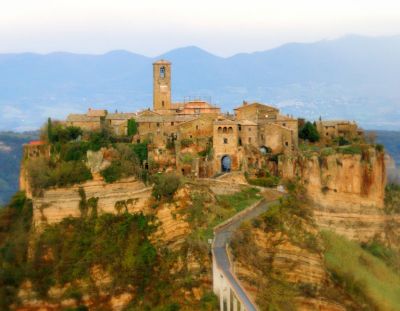Whenever the opportunity arises, a day trip to some of the many small towns and villages dotting the Italian peninsula is a wonderful way to truly rediscover traditions and flavors often forgotten or erased in the big cities; many of which are nowadays so similar to each other anywhere in the world. So, let’s go to fare due passi along some of the many such places I have photographed over the years. Most of these paesi and borghi are well outside the usual tourist’s destinations and often rather difficult to reach, however, once there, the discoveries will make all the efforts well worth it!
Calcata (fig. 1) is located about 90 minutes east of Rome and about 1,500 ft. above sea level. Once abandoned by all its residents because of a perceived high risk of earthquakes, it has gradually come back to life as an “artist colony,” with a multitude of small shops, galleries and trattorias happily filling its alleys and tiny squares. Sperlonga (fig. 2) is found on the way to the Amalfi Coast, sitting high on the Tyrrhenian Sea where the Romans once went to get a bit of relief from the summer heat. All its buildings can only be painted white, however bright colors are allowed to detail doors and window shutters. A quaint, small hotel is found just outside the village, where modern parking facilities are provided, since the village can only be visited on foot. Sermoneta (fig. 3) is a mid-size walled hill town within Latina’s territory, two hours south of Rome. As one of the best-preserved Italian Medieval villages, it has a very long and proud history going back to before Roman times, since it was cited by Virgil in the Aeneid as Sulmo. The magnificent Caetani Castle (fig. 4) dominates the village and the surrounding Pontine Plains. Bolgheri (fig. 5), near Castagneto Carducci where the great Italian poet Giosue’ Carducci was born, is located within the Maremma region of Tuscany and fairly close to Livorno, an important Naval Base and the home of the Italian Naval Academy. This is a major wine producing region and many of the “Supertuscan” wineries (fig. 6) are based around the spectacular countryside. This is a great destination for first class cheeses, salami and incredible wines. Ariccia (fig. 7) is a short trip south of Rome in the beautiful hills of the Castelli Romani between the Albano and Nemi Lakes. A local family has perfected the porchetta recipe and for generations the Ciulli pulled pork purveyors have been known for their outstanding panini (fig. 8) for which many will not hesitate to drive quite a distance! Our last stop is Civita di Bagnoregio (fig. 9), south of Orvieto: simply magical, as one arrives to the edge of the old village, approachable only via a long, narrow bridge built over a wide valley where a couple of creeks run through. As the village continues to deteriorate, only a handful of inhabitants still live here. Civita has become a major touristic attraction in the area and a favorite site for movie production, thanks to its spectacular ambiance.
Buon viaggio to all if you ever manage to reach any of these wonderful paesi!
https://www.lagazzettaitaliana.com/photo-exhibit/8591-fare-due-passi#sigProIda070ec9bab




